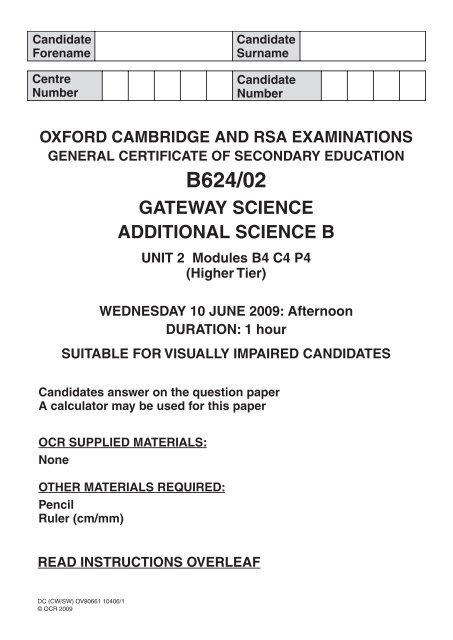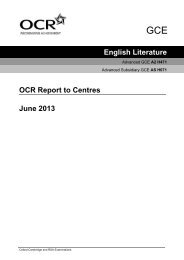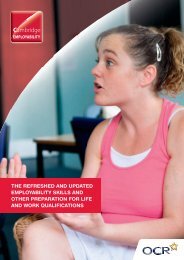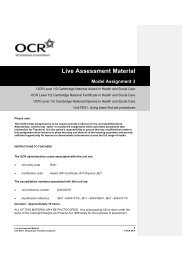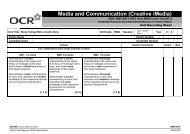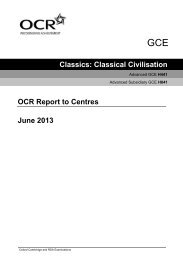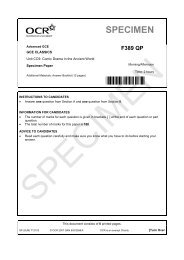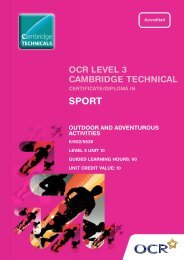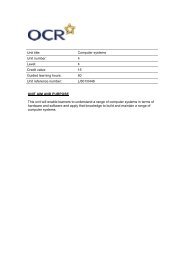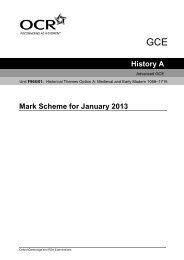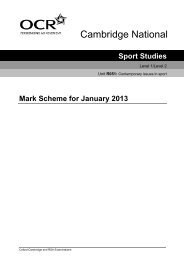Unit B624/02 - OCR
Unit B624/02 - OCR
Unit B624/02 - OCR
You also want an ePaper? Increase the reach of your titles
YUMPU automatically turns print PDFs into web optimized ePapers that Google loves.
Candidate<br />
Forename<br />
Centre<br />
Number<br />
Candidate<br />
Surname<br />
Candidate<br />
Number<br />
OXFORD CAMBRIDGE AND RSA EXAMINATIONS<br />
GENERAL CERTIFICATE OF SECONDARY EDUCATION<br />
<strong>B624</strong>/<strong>02</strong><br />
GATEWAY SCIENCE<br />
ADDITIONAL SCIENCE B<br />
UNIT 2 Modules B4 C4 P4<br />
(Higher Tier)<br />
WEDNESDAY 10 JUNE 2009: Afternoon<br />
DURATION: 1 hour<br />
SUITABLE FOR VISUALLY IMPAIRED CANDIDATES<br />
Candidates answer on the question paper<br />
A calculator may be used for this paper<br />
<strong>OCR</strong> SUPPLIED MATERIALS:<br />
None<br />
OTHER MATERIALS REQUIRED:<br />
Pencil<br />
Ruler (cm/mm)<br />
READ INSTRUCTIONS OVERLEAF<br />
DC (CW/SW) OV90661 10406/1<br />
© <strong>OCR</strong> 2009
INSTRUCTIONS TO CANDIDATES<br />
• Write your name clearly in capital letters, your Centre<br />
Number and Candidate Number in the boxes on the<br />
first page.<br />
• Use black ink. Pencil may be used for graphs and<br />
diagrams only.<br />
• Read each question carefully and make sure that<br />
you know what you have to do before starting your<br />
answer.<br />
• Answer ALL the questions.<br />
• Write your answer to each question in the space<br />
provided, however additional paper may be used if<br />
necessary.<br />
INFORMATION FOR CANDIDATES<br />
• The number of marks is given in brackets [ ] at the<br />
end of each question or part question.<br />
• A list of physics equations is printed on page three.<br />
• The Periodic Table is printed on the back page.<br />
• The total number of marks for this paper is 60.<br />
2
EQUATIONS<br />
speed =<br />
distance<br />
time taken<br />
acceleration =<br />
change in speed<br />
time taken<br />
force = mass × acceleration<br />
work done = force × distance<br />
power =<br />
work done<br />
time<br />
kinetic energy = 1 2 mv2<br />
potential energy = mgh<br />
weight = mass × gravitational field strength<br />
resistance = voltage<br />
current<br />
3
BLANK PAGE<br />
4
Answer ALL the questions.<br />
SECTION A – MODULE B4<br />
1 Read this newspaper article carefully.<br />
THE BLUE HOLE<br />
Scientists have just discovered a deep, blue hole in a<br />
forest in the Bahamas.<br />
The hole is full of water and is about 35 metres deep.<br />
At the surface the water is pure. Deeper into the hole,<br />
it becomes more and more salty and contains less<br />
oxygen.<br />
At the bottom of the hole scientists have found the<br />
bodies of animals and plants that have not decayed.<br />
They are thousands of years old.<br />
“The plants are so well preserved they still have green<br />
chloroplasts” said one scientist.<br />
(a) The decomposers can NOT decay the dead<br />
animals and plants at the bottom of the hole.<br />
Write down TWO reasons why.<br />
1 _________________________________________<br />
2 _______________________________________ [2]<br />
5
(b) The decay of dead plants and animals is an<br />
important step in the nitrogen cycle.<br />
The diagram shows part of the cycle.<br />
proteins and<br />
urea<br />
A<br />
nitrates<br />
nitrogen<br />
gas<br />
D<br />
C<br />
B<br />
ammonium<br />
compounds<br />
(i) Which step in the cycle shows decay?<br />
Choose from A, B, C or D.<br />
answer __________ [1]<br />
(ii) Nitrogen gas can be converted into nitrogen<br />
compounds, such as nitrates.<br />
Write down TWO ways that this can happen.<br />
1 ______________________________________<br />
2 ____________________________________ [2]<br />
6
(c) The scientist says that the plants still have green<br />
chloroplasts.<br />
Which cells in plant leaves contain most<br />
chloroplasts?<br />
________________________________________ [1]<br />
[Total: 6]<br />
7
2 A greenfly feeds from the stem of a tomato plant.<br />
The greenfly pushes a hollow tube into one of the<br />
tissues in the plant stem.<br />
It can then take sugar from this tissue.<br />
(a) Suggest which tissue the greenfly is most likely to<br />
pierce to get the sugar solution.<br />
Put a ring around the answer in this list.<br />
EPIDERMIS<br />
PHLOEM<br />
PALISADE<br />
XYLEM<br />
[1]<br />
8
(b) Tomato plants are often grown in glasshouses.<br />
The plants produce fewer tomatoes when<br />
greenflies feed on them.<br />
A gardener releases some wasps into his<br />
glasshouse.<br />
The wasps eat the greenflies.<br />
(i) The following diagram gives information about<br />
the food chain in the glasshouse.<br />
wasps<br />
greenflies<br />
tomato<br />
plants<br />
Write down the name of this type of diagram.<br />
_____________________________________ [1]<br />
9
(ii) Using wasps to eat greenflies is an example of<br />
biological control.<br />
Many gardeners prefer to use biological<br />
control instead of chemical pesticides.<br />
Write down TWO advantages of using<br />
biological control.<br />
1 ______________________________________<br />
_______________________________________<br />
2 ______________________________________<br />
_____________________________________ [2]<br />
[Total: 4]<br />
10
3 Plants need minerals to grow.<br />
They usually get these minerals from the soil.<br />
(a) Some plants can NOT get enough minerals from<br />
the soil.<br />
Their leaves are adapted to trap insects.<br />
They digest the insects to get the minerals they<br />
need.<br />
One plant that does this is the venus fly trap.<br />
The venus fly trap does not get enough nitrates<br />
from the soil.<br />
Instead it gets nitrogen compounds from the<br />
insects.<br />
(i) What do plants look like if they do not get<br />
enough nitrates?<br />
_____________________________________ [1]<br />
(ii) The venus fly trap also needs magnesium<br />
compounds.<br />
Write down ONE chemical in the plant that<br />
contains magnesium.<br />
_____________________________________ [1]<br />
11
(b) Plants like the venus fly trap use energy to make<br />
traps to catch insects.<br />
This energy comes from sugars made in<br />
photosynthesis.<br />
The graph shows how different numbers of traps<br />
affect the growth of a plant.<br />
growth<br />
of<br />
the<br />
plant in<br />
arbitrary<br />
units<br />
4<br />
3<br />
2<br />
1<br />
0<br />
0 1 2 3 4 5 6 7 8 9 10<br />
number of traps on the plant<br />
(i) Use the graph to predict how many traps a<br />
plant should make for maximum growth.<br />
_________________ [1]<br />
(ii) Suggest why the plant grows LESS well if it<br />
makes more or less traps.<br />
_______________________________________<br />
_______________________________________<br />
_____________________________________ [2]<br />
12
(iii) Most plant leaves are NOT adapted to catch<br />
insects.<br />
The leaves are adapted for photosynthesis by<br />
being broad and thin.<br />
Explain how these adaptations help with<br />
photosynthesis.<br />
Leaves are broad because<br />
_______________________________________<br />
_______________________________________<br />
Leaves are thin because<br />
_______________________________________<br />
_____________________________________ [2]<br />
[Total: 7]<br />
13
4 Anil is growing some lettuce plants in his garden.<br />
Normally they grow with the leaves held upright.<br />
Anil goes outside on a hot day to look at the lettuce<br />
plants.<br />
He sees that the plants look different. The leaves on<br />
the plants have drooped downwards.<br />
(a) Anil’s lettuce plants have lost water and wilted.<br />
Why does loss of water from the plants cause<br />
wilting?<br />
__________________________________________<br />
__________________________________________<br />
________________________________________ [2]<br />
(b) In what conditions would Anil’s plants wilt<br />
fastest?<br />
Put a tick (3) in the box next to the correct<br />
answer.<br />
light and humid<br />
dark and warm<br />
dry and windy<br />
windy and humid<br />
[1]<br />
14<br />
[Total: 3]
BLANK PAGE<br />
15
SECTION B – MODULE C4<br />
5 This question is about<br />
fertilisers.<br />
Look at the diagram.<br />
It shows the label on<br />
a bag of fertiliser.<br />
(a) Ammonium nitrate, NH 4<br />
NO 3<br />
, is a fertiliser.<br />
(i) Anna makes some ammonium nitrate crystals.<br />
She uses ammonia solution and an acid.<br />
Write down the NAME of the acid.<br />
_____________________________________ [1]<br />
(ii) What is the relative formula mass (M r<br />
) of<br />
ammonium nitrate, NH 4<br />
NO 3<br />
?<br />
The relative atomic mass (A r<br />
) of H is 1, of N is<br />
14 and of O is 16.<br />
_______________________________________<br />
_______________________________________<br />
relative formula mass is ________________ [1]<br />
16
(b) The overuse of fertilisers sometimes causes<br />
eutrophication.<br />
Eutrophication may cause living things in the<br />
water to die.<br />
Write about what happens during eutrophication.<br />
Include in your answer<br />
• how the fertiliser gets into the water<br />
• what the fertiliser does in the water<br />
• how this affects the living things in the<br />
water.<br />
__________________________________________<br />
__________________________________________<br />
__________________________________________<br />
________________________________________ [3]<br />
[Total: 5]<br />
17
6 This question is about washing powders.<br />
(a) Suggest a reason, other than cost, why it is good<br />
to wash clothes at 40 °C rather than at 50 °C.<br />
__________________________________________<br />
________________________________________ [1]<br />
(b) A detergent molecule has two ends<br />
• a hydrophilic head<br />
• a hydrophobic tail.<br />
hydrophilic<br />
hydrophobic<br />
(i) What does the HYDROPHILIC head do during<br />
cleaning?<br />
_____________________________________ [1]<br />
(ii) What does the HYDROPHOBIC tail do during<br />
cleaning?<br />
_____________________________________ [1]<br />
18
(c) Another way of cleaning clothes is to use a dry<br />
cleaning solvent.<br />
(i) What is meant by DRY cleaning?<br />
_____________________________________ [1]<br />
(ii) Why is dry cleaning sometimes used instead<br />
of normal washing?<br />
_____________________________________ [1]<br />
[Total: 5]<br />
19
7 This question is about water.<br />
Water is taken from lakes and reservoirs.<br />
The water contains microbes, soluble materials and<br />
insoluble materials.<br />
Water is treated to make it safe for drinking.<br />
Look at the diagram opposite.<br />
It shows some of the stages used in treating water.<br />
(a) (i) Explain what happens during sedimentation.<br />
_____________________________________ [1]<br />
(ii) Explain why the water goes through a<br />
chlorination process.<br />
_____________________________________ [1]<br />
(b) River water may contain many substances before<br />
it is purified.<br />
The water may contain PESTICIDES.<br />
The pesticides get into the river from the land.<br />
Suggest how pesticides get into the river.<br />
________________________________________ [1]<br />
20
lakes and<br />
reservoirs sedimentation<br />
filtration<br />
chlorination<br />
drinking<br />
water<br />
21
(c) Sodium chloride reacts with silver nitrate.<br />
Sodium nitrate and silver chloride are made.<br />
Write a WORD equation for this reaction. [1]<br />
__________<br />
+ __________<br />
__________<br />
+ __________<br />
__________<br />
__________<br />
__________<br />
__________<br />
(d) Barium chloride, BaCl 2<br />
, reacts with sodium<br />
sulfate, Na 2<br />
SO 4<br />
.<br />
Barium sulfate, BaSO 4<br />
, and sodium chloride, NaCl,<br />
are made.<br />
Write a BALANCED SYMBOL equation for this<br />
reaction.<br />
________________________________________ [2]<br />
[Total: 6]<br />
22
8 This question is about acids and bases.<br />
An acid and base react together.<br />
A salt and water are made.<br />
(a) Look at the list.<br />
It shows the names of some salts.<br />
AMMONIUM CHLORIDE<br />
AMMONIUM NITRATE<br />
AMMONIUM SULFATE<br />
POTASSIUM SULFATE<br />
SODIUM CHLORIDE<br />
SODIUM NITRATE<br />
Sodium hydroxide reacts with hydrochloric acid.<br />
Write down the name of the salt made.<br />
Choose from the list.<br />
________________________________________ [1]<br />
(b) Calcium nitrate, Ca(NO 3<br />
) 2<br />
, is another salt.<br />
(i) How many different ELEMENTS are there in<br />
this formula?<br />
_____________________________________ [1]<br />
23
(ii) John makes some calcium nitrate in the<br />
laboratory.<br />
He expects to make 80 g of calcium nitrate.<br />
He only makes 64 g.<br />
Calculate his percentage yield.<br />
_______________________________________<br />
_______________________________________<br />
_______________________________________<br />
answer ________ % [2]<br />
[Total: 4]<br />
24
BLANK PAGE<br />
25
SECTION C – MODULE P4<br />
9 This question is about static electricity.<br />
(a) Static electricity can be dangerous when refuelling<br />
an aircraft.<br />
Suggest why.<br />
__________________________________________<br />
________________________________________ [1]<br />
(b) A plastic ruler is rubbed with a cloth.<br />
The ruler becomes POSITIVELY charged.<br />
Explain how the ruler becomes positively charged.<br />
__________________________________________<br />
__________________________________________<br />
________________________________________ [2]<br />
26
(c) Static electricity can also be useful.<br />
It is used in hospitals.<br />
A doctor can RESTART a patient’s HEART.<br />
He puts the paddles on the patient’s chest.<br />
The paddles are charged.<br />
Describe what happens next.<br />
In your answer write about<br />
• how the heart restarts<br />
• the precautions taken.<br />
__________________________________________<br />
__________________________________________<br />
__________________________________________<br />
________________________________________ [2]<br />
[Total: 5]<br />
27
10 A hair dryer is an electrical appliance.<br />
(a) The hair dryer is DOUBLE INSULATED.<br />
It is not earthed.<br />
Explain why the hair dryer is not earthed.<br />
__________________________________________<br />
________________________________________ [1]<br />
(b) The hair dryer is connected to a 230 V mains<br />
supply.<br />
The current through the hair dryer is 5 A.<br />
Calculate the RESISTANCE of the hair dryer.<br />
The equations on page 3 may help you.<br />
__________________________________________<br />
__________________________________________<br />
answer _______ ohms [2]<br />
[Total: 3]<br />
28
11 ULTRASOUND scans are used in hospitals.<br />
(a) Ultrasound waves are used to build up a picture of<br />
an unborn baby.<br />
Explain how the waves build up this picture.<br />
__________________________________________<br />
__________________________________________<br />
________________________________________ [2]<br />
(b) X-rays are NOT used for scanning unborn babies.<br />
One reason is that X-rays can damage living cells.<br />
Write down ONE OTHER reason why X-rays are<br />
not used.<br />
__________________________________________<br />
________________________________________ [1]<br />
[Total: 3]<br />
29
12 Gamma rays and X-rays are used to treat cancer.<br />
(a) Gamma rays come from the nucleus of some<br />
radioactive materials.<br />
How are X-rays made?<br />
__________________________________________<br />
________________________________________ [1]<br />
(b) (i) X-rays are often better than gamma rays for<br />
cancer treatment.<br />
Suggest why.<br />
_______________________________________<br />
_____________________________________ [1]<br />
30
(ii) An X-ray gun is rotated around a cancer<br />
patient’s head.<br />
tumour<br />
X-ray gun<br />
moves<br />
around in<br />
a circle<br />
patient’s head<br />
The X-rays are always aimed at the tumour.<br />
This kills the cancer cells from all directions.<br />
Give ONE OTHER reason why the X-ray gun is<br />
moved around the cancer patient’s head.<br />
_______________________________________<br />
_____________________________________ [1]<br />
[Total: 3]<br />
31
13 There are three types of nuclear radiation.<br />
These are alpha, beta and gamma.<br />
Look at the table.<br />
TYPE OF RADIATION<br />
alpha<br />
beta<br />
gamma<br />
DESCRIPTION<br />
4<br />
2 He<br />
0<br />
–1<br />
electromagnetic wave<br />
(a) The nucleus of a radioactive atom decays and<br />
emits alpha, beta or gamma radiation.<br />
What is special about a radioactive nucleus?<br />
Finish the sentence.<br />
A radioactive atom decays because its nucleus<br />
is ____________________________________ . [1]<br />
(b) An alpha particle is a helium nucleus.<br />
What is a beta particle?<br />
Finish the sentence.<br />
A beta particle is a high speed<br />
______________________________________ . [1]<br />
32
(c) Background radiation is always present in the<br />
environment.<br />
Where does background radiation come from?<br />
Write down TWO sources of background radiation.<br />
1 _________________________________________<br />
2 _______________________________________ [2]<br />
(d) An americium nucleus, Am, decays.<br />
It emits an alpha particle.<br />
A new element, Q, is produced.<br />
Look at the equation.<br />
241<br />
95 Am X<br />
Y Q + 4 2 He<br />
(i) What is the MASS NUMBER (X) of Q?<br />
_____________________________________ [1]<br />
(ii) What is the ATOMIC NUMBER (Y) of Q?<br />
_____________________________________ [1]<br />
[Total: 6]<br />
END OF QUESTION PAPER<br />
33
BLANK PAGE<br />
34
Copyright Information<br />
<strong>OCR</strong> is committed to seeking permission to reproduce all third-party content<br />
that it uses in its assessment materials. <strong>OCR</strong> has attempted to identify and<br />
contact all copyright holders whose work is used in this paper. To avoid the<br />
issue of disclosure of answer-related information to candidates, all copyright<br />
acknowledgements are reproduced in the <strong>OCR</strong> Copyright Acknowledgements<br />
Booklet. This is produced for each series of examinations, is given to all<br />
schools that receive assessment material and is freely available to download<br />
from our public website (www.ocr.org.uk) after the live examination series.<br />
If <strong>OCR</strong> has unwittingly failed to correctly acknowledge or clear any<br />
third-party content in this assessment material, <strong>OCR</strong> will be happy to correct<br />
its mistake at the earliest possible opportunity.<br />
For queries or further information please contact the Copyright Team, First<br />
Floor, 9 Hills Road, Cambridge CB2 1PB.<br />
<strong>OCR</strong> is part of the Cambridge Assessment Group; Cambridge Assessment<br />
is the brand name of University of Cambridge Local Examinations Syndicate<br />
(UCLES), which is itself a department of the University of Cambridge.<br />
35
The Periodic Table of the Elements<br />
1 2 3 4 5 6 7 0<br />
Key<br />
1<br />
H<br />
hydrogen<br />
1<br />
4<br />
He<br />
helium<br />
2<br />
7<br />
Li<br />
lithium<br />
3<br />
9<br />
Be<br />
beryllium<br />
4<br />
relative atomic mass<br />
atomic symbol<br />
name<br />
atomic (proton) number<br />
11<br />
B<br />
boron<br />
5<br />
12<br />
C<br />
carbon<br />
6<br />
14<br />
N<br />
nitrogen<br />
7<br />
16<br />
O<br />
oxygen<br />
8<br />
19<br />
F<br />
fluorine<br />
9<br />
20<br />
Ne<br />
neon<br />
10<br />
23<br />
Na<br />
sodium<br />
11<br />
24<br />
Mg<br />
magnesium<br />
12<br />
27<br />
Al<br />
aluminium<br />
13<br />
28<br />
Si<br />
silicon<br />
14<br />
31<br />
P<br />
phosphorus<br />
15<br />
32<br />
S<br />
sulfur<br />
16<br />
35.5<br />
Cl<br />
chlorine<br />
17<br />
40<br />
Ar<br />
argon<br />
18<br />
39<br />
K<br />
potassium<br />
19<br />
40<br />
Ca<br />
calcium<br />
20<br />
45<br />
Sc<br />
scandium<br />
21<br />
48<br />
Ti<br />
titanium<br />
22<br />
51<br />
V<br />
vanadium<br />
23<br />
52<br />
Cr<br />
chromium<br />
24<br />
55<br />
Mn<br />
manganese<br />
25<br />
56<br />
Fe<br />
iron<br />
26<br />
59<br />
Co<br />
cobalt<br />
27<br />
59<br />
Ni<br />
nickel<br />
28<br />
63.5<br />
Cu<br />
copper<br />
29<br />
65<br />
Zn<br />
zinc<br />
30<br />
70<br />
Ga<br />
gallium<br />
31<br />
73<br />
Ge<br />
germanium<br />
32<br />
75<br />
As<br />
arsenic<br />
33<br />
79<br />
Se<br />
selenium<br />
34<br />
80<br />
Br<br />
bromine<br />
35<br />
84<br />
Kr<br />
krypton<br />
36<br />
85<br />
Rb<br />
rubidium<br />
37<br />
88<br />
Sr<br />
strontium<br />
38<br />
89<br />
Y<br />
yttrium<br />
39<br />
91<br />
Zr<br />
zirconium<br />
40<br />
93<br />
Nb<br />
niobium<br />
41<br />
96<br />
Mo<br />
molybdenum<br />
42<br />
[98]<br />
Tc<br />
technetium<br />
43<br />
101<br />
Ru<br />
ruthenium<br />
44<br />
103<br />
Rh<br />
rhodium<br />
45<br />
106<br />
Pd<br />
palladium<br />
46<br />
108<br />
Ag<br />
silver<br />
47<br />
112<br />
Cd<br />
cadmium<br />
48<br />
115<br />
In<br />
indium<br />
49<br />
119<br />
Sn<br />
tin<br />
50<br />
122<br />
Sb<br />
antimony<br />
51<br />
128<br />
Te<br />
tellurium<br />
52<br />
127<br />
I<br />
iodine<br />
53<br />
131<br />
Xe<br />
xenon<br />
54<br />
133<br />
Cs<br />
caesium<br />
55<br />
137<br />
Ba<br />
barium<br />
56<br />
139<br />
La*<br />
lanthanum<br />
57<br />
178<br />
Hf<br />
hafnium<br />
72<br />
181<br />
Ta<br />
tantalum<br />
73<br />
184<br />
W<br />
tungsten<br />
74<br />
186<br />
Re<br />
rhenium<br />
75<br />
190<br />
Os<br />
osmium<br />
76<br />
192<br />
Ir<br />
iridium<br />
77<br />
195<br />
Pt<br />
platinum<br />
78<br />
197<br />
Au<br />
gold<br />
79<br />
201<br />
Hg<br />
mercury<br />
80<br />
204<br />
Tl<br />
thallium<br />
81<br />
207<br />
Pb<br />
lead<br />
82<br />
209<br />
Bi<br />
bismuth<br />
83<br />
[209]<br />
Po<br />
polonium<br />
84<br />
[210]<br />
At<br />
astatine<br />
85<br />
[222]<br />
Rn<br />
radon<br />
86<br />
[223]<br />
Fr<br />
francium<br />
87<br />
[226]<br />
Ra<br />
radium<br />
88<br />
[227]<br />
Ac*<br />
actinium<br />
89<br />
[261]<br />
Rf<br />
rutherfordium<br />
104<br />
[262]<br />
Db<br />
dubnium<br />
105<br />
[266]<br />
Sg<br />
seaborgium<br />
106<br />
[264]<br />
Bh<br />
bohrium<br />
107<br />
[277]<br />
Hs<br />
hassium<br />
108<br />
[268]<br />
Mt<br />
meitnerium<br />
109<br />
[271]<br />
Ds<br />
darmstadtium<br />
110<br />
[272]<br />
Rg<br />
roentgenium<br />
111<br />
Elements with atomic numbers 112-116 have been reported but not fully<br />
authenticated<br />
* The lanthanoids (atomic numbers 58-71) and the actinoids (atomic numbers 90-103) have been omitted.<br />
The relative atomic masses of copper and chlorine have not been rounded to the nearest whole number.<br />
GCSESC~1.DOC Page 4 of 4<br />
36


